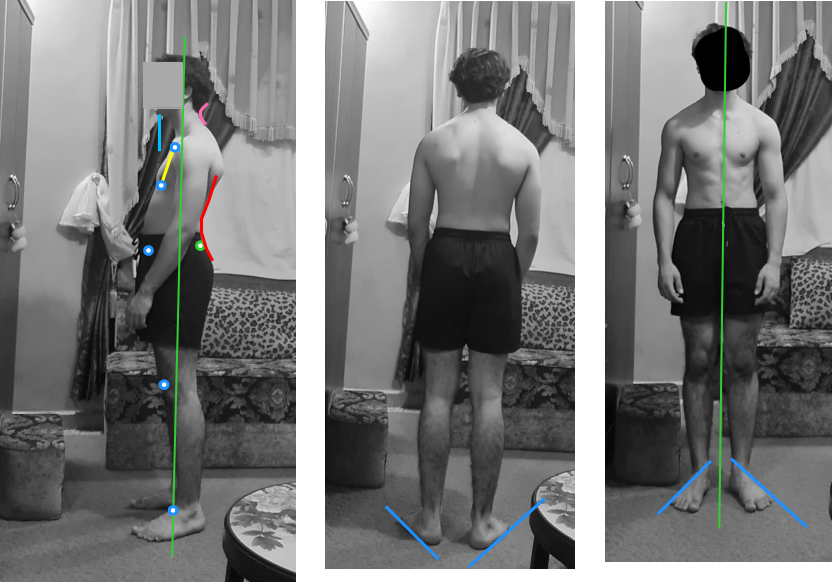
Before I start explaining what I see, I should mention that the green plumb lines have been adjusted according to the vertical lines in the background in order to compensate for the distortion and placement of camera – it was particularly hard on the posterior view, so I decided to not place any (rather then guess).
Feet in a wrong position. Toes wide apart to heels. The blue lines on the anterior (front) and posterior (back) views which we call “outsteps” are converging at the back. They should actually be parallel to each other.
Right foot arch more collapsed then the left.
Your knees and ankles are released (they are not in full extension).
You have a slight “anterior pelvic tilt”, which in other words means that you are lifting your sacrum too high up (the green spot) and therefore shifting your iliacs (anterior superior iliac spine) forward and down – the iliacs and sacrum are part of the same object – the pelvis.
The yellow line is your sternum, which is the front of your ribcage. Your ribcage is rotated backwards at the top (opposite rotation to the pelvic one), which you can easily see by the slope of the sternum. Ribcage is pretty much inbetween the yellow line and the top part of the red curve at your back. The rotation of the pelvis + ribcage bends your spine as shown by the red curve. You are shortening and narrowing your torso by doing that (not good).
There are few blue spots shown: (ankles, knees, iliacs [anterior superior iliac spine], bottom and top sternum). All these spots would ideally be on the green plumb line and that’s the reference we use for judging how organised ones mechanism is.
You are retracting the mechanism of your arms, pulling your shoulders too high up and back. Your shoulderblades are visibly retracted, causing the crests to stick out ( angle wings / protruding shoulderblades).
The pink curve at your cervical spine shows the shortening of your neck. This is related to your arms being shifted too far back and shoulders being lifted too high up. Head is retracted – the blue vertical line of your chin should be well and truly forward past the bottom sternum (forwards).
Now to be honest, there is something that doesn’t quite add up on the front / back images regarding the plumb lines. It may be due to the angle of the camera, but I’m not entirely sure. From the anterior view, looks to me as if you would be predominantly loading your right foot (shifting more weight to your right). I think the posterior view corresponds, but I just couldn’t place the plumbline. I reckon the loading is still visible though.
All of the above is just how you habitually move the different parts of your mechanism in relation to each other. It’s unconscious movements (as in you aren’t consciously trying to move like this – it just happens).
It’s all 100% fixable – I can teach you how if you like (or any other initial Alexander Technique teacher will be able to do the same).
Hope that helps. Hit me up with more questions, if you have.